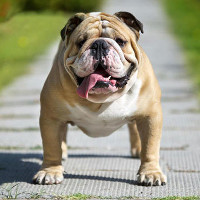Appearance of the Victorian Bulldog
|
| Mr. Mollett's standard for the Victorian Bulldog describes them as a medium-sized dog, measuring around 46 centimeters at the shoulder and weighing between 25 and 34 kilos. Like the English Bulldog, they are thickset, muscular, with a large head and muscular neck, but these qualities must not be exaggerated to the point of impairing the dog's health or movement. Their broad, upturned muzzle should be short, but not too short so as not to impede breathing, and their lower jaw has a square bite. They have dark, low-set eyes and medium to short, forward-facing ears that should never be cropped. The tail may be straight or lowered or corkscrew-shaped, but it will not be carried over the back and their short coat may be any color of brindle, or white, or red, fawn, pied, or fallow with white markings. |
Temperament of the Victorian Bulldog
|
| While the English Bulldog was originally an aggressive animal, capable of controlling bulls many times its size, breeding preferences changed after the sport of bull baiting became illegal, and breeders focused on creating a gentler dog with a tractable personality. The Victorian Bulldog inherited this softer personality and they generally get on very well with humans and most other types of animals, although they can sometimes be a bit crazy when dealing with other dogs. Although all interactions between dogs and young children need to be closely supervised, the Victorian Bulldog is generally very tolerant of their behavior. Their placid but stubborn personality can make training a challenge, but they can learn it by adopting a positive attitude as well as lots of praise and treats. Although these dogs may take a while to get the hang of things, they tend to remember once they've learned something. |
Needs and activities of the Victorian Bulldog
|
| While most Victorian Bulldogs are more than happy to stay in the living room all day, these muscular dogs need daily exercise to maintain their fitness and avoid obesity. While English Bukkdogs may have difficulty with long or arduous walks due to respiratory problems and shortened legs, Victorian Bulldogs generally have more stamina due to their elongated muzzle and legs. They are slightly more sensitive to heat and cold than many other breeds. These dogs may seem a little large for an average apartment, but their nonchalant attitude inside homes tends to make them pleasant bedfellows, even in small spaces. |
Maintenance of the Victorian Bulldog
|
| The Victorian Bulldog generally requires a little more bathing than many other breeds, and should be bathed every month or two to avoid odors. Although they have fewer wrinkles than their English Bulldog ancestors, it's still important to check the wrinkles they have frequently to make sure they haven't trapped dirt or moisture, which can promote the onset of skin problems. Their short coats therefore get a little wet and need to be brushed once a week to keep their fur clean and shiny. Particular attention must be paid to dental hygiene in lower-jawed dogs such as the Victorian Bulldog. |







 English (United Kingdom)
English (United Kingdom)